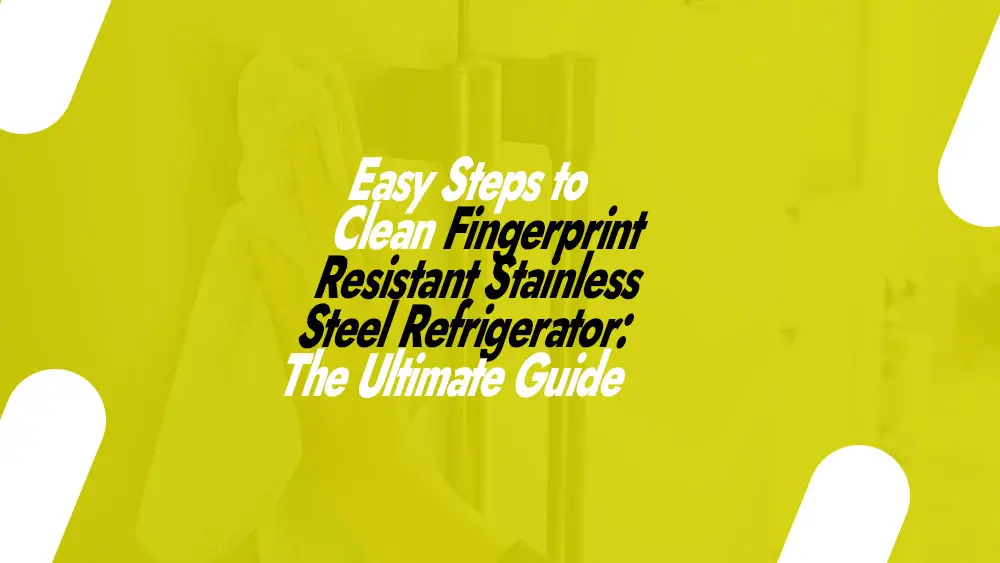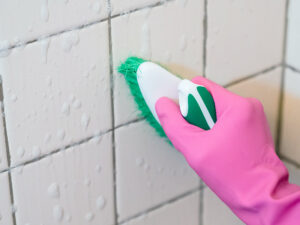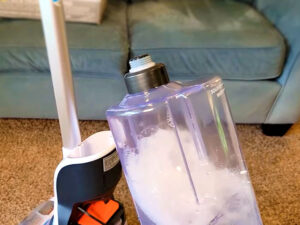I’ve always found it hard to keep a fridge made of fingerprint-resistant stainless steel looking clean and sleek. No matter how careful I was, those annoying smudges and marks always seemed to show up out of nowhere and ruin the perfect look of my device. But over time, I’ve learned some good ways to keep my fridge looking its best without having to fight all the time.
In this blog post, I’ll show you my tried-and-true ways to clean stainless steel that doesn’t show fingerprints. I’ll show you step by step how to do everything, from finding the right cleaning products to wiping them down the right way. Say goodbye to fingerprints and hello to a clean, shiny refrigerator that will make your kitchen look better as a whole. Let’s dive in and find out the best ways to keep your stainless steel appliances looking shiny and new.
How to Clean Your Stainless Steel Refrigerator That Won’t Show Fingerprints
Your fingerprint-resistant stainless steel refrigerator needs to be cleaned often to keep it looking sleek and shiny. Its elegant look can be quickly ruined by fingerprints, smudges, and other marks. With the right cleaning tools and a few easy steps, you can keep your fridge looking like it just came out of the store. In this guide, we’ll show you eight detailed steps for how to clean your stainless steel refrigerator without leaving fingerprints.

Step 1: Get the things you need
Gather all the things you’ll need to clean before you start. A soft microfiber cloth, warm water, light dish soap, vinegar or stainless steel cleaner, a spray bottle, and a clean towel are some of these things.
Step 2: Get the cleaning solution ready
Start by making a solution to clean with. Mix the same amount of warm water and light dish soap in a spray bottle. You could also use an industrial stainless steel cleaner or mix equal parts vinegar and water. Gently shake the spray bottle to make sure all the ingredients are mixed well.
Step 3: Get rid of dirt and debris on the surface
Start cleaning by wiping the refrigerator’s surface with a dry microfiber cloth to get rid of any loose dirt or dust. This step helps keep the surface from getting scratched while it’s being cleaned.
Step 4: Use the cleaning product
Spray the cleaning solution on a soft microfiber cloth instead of directly on the surface of the refrigerator. This keeps liquid from getting into the seams or control panels of the device, which could damage them. Make sure the cloth is damp but not dripping wet.
Step 5: Clean the surface of the stainless steel
Wipe the surface of the stainless steel gently with the wet microfiber cloth in the direction of the grain. The grain is the term for the lines on the surface of the steel. Use a light touch and keep wiping until all the fingerprints, smudges, and other marks are gone. You can put a little more pressure on spots that won’t come out, but don’t use rough materials or scrub brushes that could scratch the surface.
Step 6: Rinse and let dry
After you’ve cleaned the whole surface, rinse the microfiber cloth with clean water and wring it out well. Then, use the wet cloth to wipe away any soap residue that is still on the stainless steel. Make sure you don’t leave any soap or cleaning solution behind, as this can leave lines or make the surface look dull. After giving the surface a good rinse, dry it with a dry microfiber cloth, wiping in the direction of the wood grain.
Step 7: Smooth the surface, if you want to
Use a stainless steel polish made for machines that don’t show fingerprints to make them shine even more. Use a clean microfiber cloth and a small amount of the shine to buff the surface in circles. Follow the directions given by the maker of the polish you are using. But keep in mind that polishing is optional and may not be needed for normal maintenance.
Step 8: Keep the surface clean
Maintaining your stainless steel refrigerator will keep it looking its best. Don’t use harsh cleaners or scrub brushes, as they can hurt the surface. Instead, use light dish soap, vinegar, or a cleaner for stainless steel surfaces that are made to not leave fingerprints. Also, be careful about what touches the top of the stainless steel. Don’t use steel wool, rough sponges, or strong chemicals. Use a dry microfiber cloth to wipe down the surface often to remove any smudges or fingerprints that may build up.
If you follow these eight detailed steps, you’ll be able to clean your stainless steel refrigerator well and keep it looking like new. With regular cleaning and care, your device will continue to look great and add style to your kitchen for years to come.
Other Ways to Clean Your Stainless Steel Refrigerator that Doesn’t Show Fingerprints
The previous guide gave a full rundown of the standard cleaning steps. Here are more specific explanations of other ways to clean a stainless steel refrigerator that doesn’t show fingerprints:
Baking Soda Paste
To make a baking soda paste, mix together baking soda and water until it gets thick. The paste is a mild abrasive that helps get rid of tough spots or grime on the surface of stainless steel. Put the paste on a soft cloth and rub it in circles on the affected areas. Be careful not to put too much pressure on the surface so you don’t scratch it. After you’ve gotten rid of the stains, rinse the area well with water and dry it with a clean cloth to make sure nothing is left behind.
Lemon Juice
Because lemon juice is naturally acidic, it can be used to clean stainless steel surfaces. Cut a lemon in half and squeeze the juice into a bowl. Put some lemon juice on a soft cloth and rub it on the stainless steel, paying special attention to spots with fingerprints or stains. Dirt and grease will be broken up by the lemon juice, leaving the surface clean and shiny. Rinse the area with water to get rid of any leftover lemon juice, then dry it with a clean cloth.
Oil from olives
Olive oil not only cleans stainless steel, but it also gives it a nice shine. Pour a small amount of olive oil onto a soft towel and rub it on the surface in the direction of the grain. The oil helps get rid of fingerprints and leaves a protection layer that keeps the surface from getting dirty again. Once you’ve covered the whole surface, use a clean cloth to remove any extra oil, giving the stainless steel refrigerator a polished look.
Cleaner for Glass
If you would rather use a professional cleaner, choose one that doesn’t contain ammonia and is safe for stainless steel. Spray the glass cleaner onto a soft cloth and make sure it is damp but not dripping. Wipe the surface of the stainless steel gently, making sure to wipe in the direction of the grain. Fingerprints, smudges, and other marks come off easily with the glass cleaner. Rinse the surface with water and dry it with a clean cloth to get a smooth finish without streaks.
Wipes for commercial use on stainless steel
Commercial wipes made of stainless steel are a handy way to clean your fridge. These wipes already have water on them and are made to clean stainless steel surfaces. They usually contain a light cleaning solution. Just take a wipe and gently rub it along the grain on the surface of the stainless steel. Fingerprints and smudges will come off well with the wipe. Read the notes on the package for any specific suggestions, and make sure the wipes can be used on stainless steel that doesn’t show fingerprints. After wiping, use a dry cloth to get rid of any extra water and polish the surface.
Make sure to test any alternative way to clean the fridge on a small, unnoticeable spot before using it on the whole surface. This lets you make sure they work well together and keep the stainless steel from getting damaged.
FAQs
Can I clean my stainless steel refrigerator, which doesn’t show fingerprints, with vinegar?
Yes, you can use vinegar to clean a stainless steel refrigerator that doesn’t show fingerprints. Vinegar is a natural and effective way to clean stainless steel. It can be used to get rid of fingerprints, smudges, and other marks. Mix one part vinegar to one part water in a spray bottle. Spray the solution on a soft cloth, and wipe the area in the direction of the grain. Because vinegar is acidic, it helps break down grease and dirt, leaving the stainless steel clean and shiny. But it’s important to rinse the surface with water and dry it well to get rid of any vinegar smell or residue that might be left behind.
Are abrasive sponges and steel wool safe to use on stainless steel freezers that don’t show fingerprints?
No, you shouldn’t clean fingerprint-resistant stainless steel freezers with rough sponges or steel wool. These things can scratch the surface of stainless steel, making it look bad. Instead, use soft cotton cloths or cleaning tools made just for stainless steel that isn’t rough. These soft materials clean the surface well without hurting it.
How often should I clean my stainless steel fridge that doesn’t show fingerprints?
How often you clean your stainless steel refrigerator that is resistant to fingerprints depends on how often you use it and how visible fingerprints or smudges are. As a general rule, you should clean the fridge at least once a week or whenever you can see marks. Regular cleaning keeps the gadget looking good and keeps dirt and stains from building up.
Can I clean my stainless steel refrigerator with cleaners that have ammonia in them?
Most of the time, you shouldn’t use ammonia-based cleaners on stainless steel freezers that don’t show fingerprints. Ammonia can hurt the protective covering on the surface of stainless steel, which can cause it to change color or rust. To clean stainless steel surfaces safely and well, use mild dish soap, vinegar, or cleaning products made just for stainless steel.
How do I get water spots off of my stainless steel refrigerator that doesn’t show fingerprints?
Start by cleaning the surface of your stainless steel refrigerator with a light dish soap and water solution to get rid of the water spots. If the water spots don’t go away, fill a spray bottle with equal parts vinegar and water. Spray the solution onto a soft cloth, and then rub the water spots in a circular manner with the cloth. Rinse the surface with clean water, and then dry it well to get rid of any streaks or leftover dirt.
Can I use a cleaner for stainless steel that wasn’t made for surfaces that don’t show fingerprints?
Most of the time, you should use a stainless steel cleaner made for surfaces that don’t show fingerprints, but if you need to, you can use a normal stainless steel cleaner. But be aware that some normal stainless steel cleaners may leave streaks or residue on surfaces that don’t show fingerprints. Always read the product’s label and do what the maker says to get the best results and make sure it works with other things.
What should I do if I scratch the stainless steel surface that doesn’t show fingerprints?
If you scratch the stainless steel surface, which doesn’t show fingerprints, you can try using a stainless steel scratch remover or a stainless steel cleaning product. These items are made to make scratches look less noticeable and restore the surface. Follow the directions carefully, and make sure to test the product on a small, unnoticeable spot first to make sure it works and prevents further damage.
Can I use window cleaner to clean my stainless steel fridge that doesn’t show fingerprints?
Window cleaners, especially ones with ammonia, should usually not be used to clean stainless steel freezers that don’t show fingerprints. Cleaners that contain ammonia can damage the protective layer, which can lead to rust or discoloration. To clean stainless steel in a safe and effective way, use light dish soap, vinegar, or a cleaner made just for stainless steel.
How can I keep my stainless steel refrigerator from getting fingerprints and smudges?
Use a stainless steel polish or protection spray to keep fingerprints and smudges from showing up on your stainless steel refrigerator. These items make a barrier on the surface, which makes it easier to wipe away fingerprints and smudges. Also, tell everyone in the house to use the handles instead of feeling the stainless steel surface directly. This will help cut down on fingerprints.
Does my fingerprint-resistant stainless steel fridge need to be polished often?
A fingerprint-resistant stainless steel refrigerator doesn’t need to be polished on a regular basis. The layer on the surface makes it harder for fingerprints and smudges to show up, so you don’t have to polish it. But if you want more shine or have marks that won’t come off, you can use a stainless steel cleaner that is made for surfaces that don’t show fingerprints. Follow the advice from the manufacturer and remember to gently buff the surface with a soft cloth to keep it from getting scratched.
Final Thoughts
To keep its elegant look, you need to keep your fingerprint-resistant stainless steel refrigerator clean and free of smudges and fingerprints. If you follow the steps in the book and think about other ways to clean, you can get rid of marks and bring back the shine on your appliance. Whether you use a mild dish soap solution, vinegar, lemon juice, or industrial stainless steel wipes, you should always use soft materials and stay away from tools that are too rough. With regular care and upkeep, your fingerprint-resistant stainless steel refrigerator will be a stylish part of your kitchen for many years to come.







